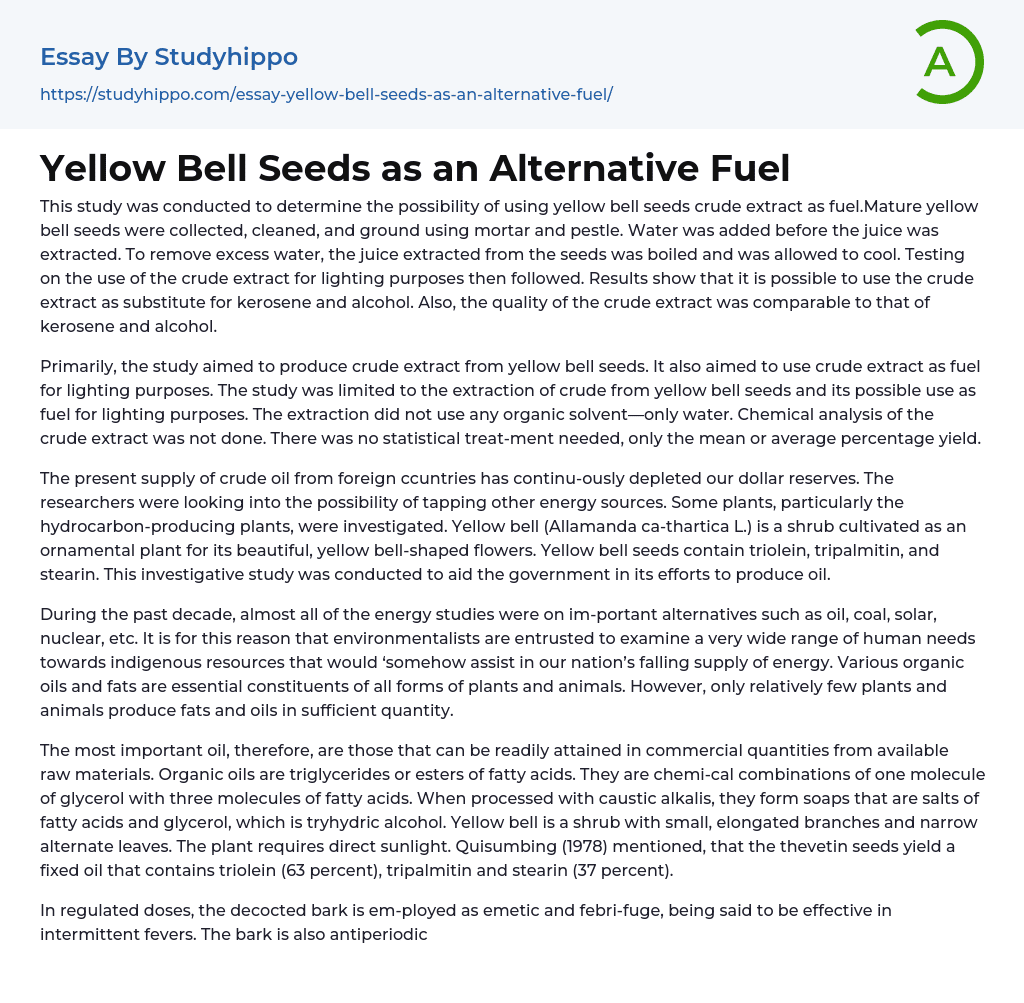This study was conducted to determine the possibility of using yellow bell seeds crude extract as fuel.Mature yellow bell seeds were collected, cleaned, and ground using mortar and pestle. Water was added before the juice was extracted. To remove excess water, the juice extracted from the seeds was boiled and was allowed to cool. Testing on the use of the crude extract for lighting purposes then followed. Results show that it is possible to use the crude extract as substitute for kerosene and alcohol. Also, the quality of the crude extract was comparable to that of kerosene and alcohol.
Primarily, the study aimed to produce crude extract from yellow bell seeds. It also aimed to use crude extract as fuel for lighting purposes. The study was limited to the extraction of crude from yellow bell seeds and its possible use as fuel for lighting purposes
.... The extraction did not use any organic solvent—only water. Chemical analysis of the crude extract was not done. There was no statistical treat-ment needed, only the mean or average percentage yield.
The present supply of crude oil from foreign ccuntries has continu-ously depleted our dollar reserves. The researchers were looking into the possibility of tapping other energy sources. Some plants, particularly the hydrocarbon-producing plants, were investigated. Yellow bell (Allamanda ca-thartica L.) is a shrub cultivated as an ornamental plant for its beautiful, yellow bell-shaped flowers. Yellow bell seeds contain triolein, tripalmitin, and stearin. This investigative study was conducted to aid the government in its efforts to produce oil.
During the past decade, almost all of the energy studies were on im-portant alternatives such as oil
coal, solar, nuclear, etc. It is for this reason that environmentalists are entrusted to examine a very wide range of human needs towards indigenous resources that would ‘somehow assist in our nation’s falling supply of energy. Various organic oils and fats are essential constituents of all forms of plants and animals. However, only relatively few plants and animals produce fats and oils in sufficient quantity.
The most important oil, therefore, are those that can be readily attained in commercial quantities from available raw materials. Organic oils are triglycerides or esters of fatty acids. They are chemi-cal combinations of one molecule of glycerol with three molecules of fatty acids. When processed with caustic alkalis, they form soaps that are salts of fatty acids and glycerol, which is tryhydric alcohol. Yellow bell is a shrub with small, elongated branches and narrow alternate leaves. The plant requires direct sunlight. Quisumbing (1978) mentioned, that the thevetin seeds yield a fixed oil that contains triolein (63 percent), tripalmitin and stearin (37 percent).
In regulated doses, the decocted bark is em-ployed as emetic and febri-fuge, being said to be effective in intermittent fevers. The bark is also antiperiodic in small doses, and the leaves are used as a cathartic. Liquid fuel is important for power generation. It is fuel oil. It is classified according to its properties, e.g., flash point, pour point, percent-age of water and sediment, carbon residue, ash distillation temperature, and viscosity. When processed with simple methods, the utilization of the yellow bell seeds will yield oil that shows the same chemical properties of fuel.
A. Materials 300 mature yellow bell seeds, knife, strainer, sterilized bottle,
frying pan, basin, mortar and pestle, evaporating dish, alcohol lamp
B. Method To prepare the extract, mature yellow bell fruits were gathered, cleaned, and weighed. The pulps or outer coverings of the fruits were removed to obtain the seeds. The shells of the seeds were opened by means of cutting them through the center linings, thus separating the kernels or flesh from the shells. Mechanical pressing ground the kernels, which originally contained moisture. Water was added to the ground seeds. The ground seeds with water were then strained using fine sieve cloth to separate the milk of the seeds.
The extracted crude oil was heated to remove the water content. It was then measured and later placed in a sterilized bottle ready for use as fuel for lamp. To test the effectiveness of the oil, different amounts were measured and placed in three different lamps. Observations were made as to its duration, brightness, etc. The results were compared to the other kinds of fuel, such as alcohol and kerosene. It shows that the crude extract oil from the yellow bell has the longest duration of lighting time. It has a stable flame, with less soot, and is brighter than alcohol. It is shows the comparison of the yellow bell oil with alcohol and kerosene.
Table 1. Quality of light produced by yellow bell crude extract as compared to alcohol and kerosene Table 1 shows that the crude extract oil from yellow bell has he longest duration of lighting time. It has a stable lame, by les soot and is brighter than alcohol.
Table 2 shows the comparison of the yellow bell oil
with alcohol and kerosene.
Table 2. Physical properties ofyellow bell crude extract as compared to alcohol and kerosene The density of yellow bell crude extract is 0.87g/ mL
Table 3 shows that as the amount of yellow bell seeds increases, the oil extracted is also increased. Twenty-two percent of the oil was extracted from each sample prepared.
Based on the results and findings of the study, the following conclusions were obtained:
1. Yellow bell seeds crude extract can be utilized in producing oil. The yellow bell oil can serve as a homemade fuel which can be a substitute to kerosene. Its lighting efficiency give a brighter effect when used as a fuel for lamp. It emits less soot as compared to kerosene. The oil can be produced with the minimum of efforts and is considered cheap.
2. The crude extract oil can be produced using simple methods like grinding, drying and straining.




